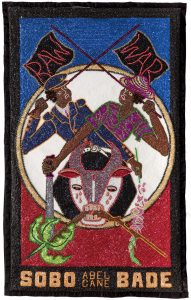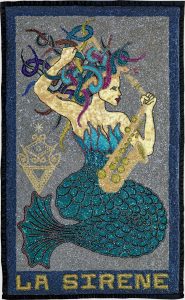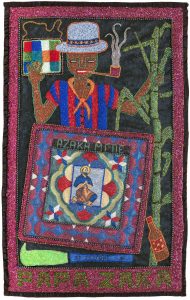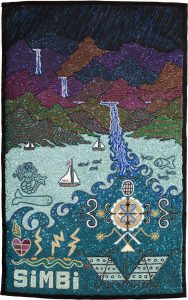Bondye: Between and Beyond, opening January 25 and on view in the Great Hall through October 13, features twelve sequined prayer flags created by the Louisiana-born artist Tina Girouard in collaboration with artists in Haiti.
During the 1990s, Girouard maintained a studio in Port-au-Prince, where she helped create these collective artworks. Sequined prayer flags are at the center of Haitian Vodou, playing an important part in communal gatherings, offerings, and rituals. Practiced throughout the world, Vodou today finds expression in ceremonies and rites ranging from All Saints Day in France to the celebration of Mardi Gras in New Orleans and Kanaval in Haiti.
These flags celebrate the religion’s multicultural roots, illustrating its melding of West African, Catholic, and Haitian spiritual practices. After thousands of enslaved people were brought to Haiti from West Africa in the sixteenth century, they were not allowed to openly practice their diverse religions and thus were forced to blend their customs with the Catholic beliefs of French and Spanish slave owners. Following the path of slavery and colonialism, this spiritual amalgam has helped form religious practices in places across the globe, including New Orleans.
Much like Vodou itself, these flags represent a coming together of different cultures, communities, and planes of existence. Each flag pays tribute to a different spirit of Haitian Vodou, called the “loa,” or “invisibles,” in Haitian Creole. These unseen entities stand at the spiritual and cultural crossroads: existing between the human and spirit world, they also move between many different nations and cultures, and are believed to speak all human languages. In Vodou rituals, sequined flags beckon these loa from beyond, who in turn bring messages of faith and hope to the supreme spiritual force of Vodou, known as “Bondye,” who represents pure goodness and the highest principle of the universe. Celebrating Vodou’s origins in community, creativity and freedom, these works prompt us to consider the ways we all exist between different cultures, and ask us to reflect on our own spirituality as well as our points of connection with the rest of humanity.
Beginning in the 1960s, Girouard was one among a prominent group of contemporary artists from Louisiana that included Keith Sonnier, Lynda Benglis, and Dickie Landry. These artists countered the more austere minimalist art being made at the time with exuberant color, eclectic compositions, and unorthodox new art materials that reflected Louisiana’s diverse local culture, but also looked out into the wider world. In works like these sequined flags, their art gave visibility to new voices and perspectives from within and beyond the borders of the United States. They often included references to a global range of cultures, either through direct collaborations with artists in places like Haiti, Japan, and India, or through appropriations of forms and influences from those cultures. Their work celebrates the power of collaboration and cross-cultural dialogue and communication, while also raising questions about authorship, ownership, and authenticity that have only become more relevant in our increasingly globalized world.
The exhibition is curated by Katie A. Pfohl, Curator of Modern and Contemporary Art, with Nicolas Brierre Aziz, Community Outreach Coordinator



